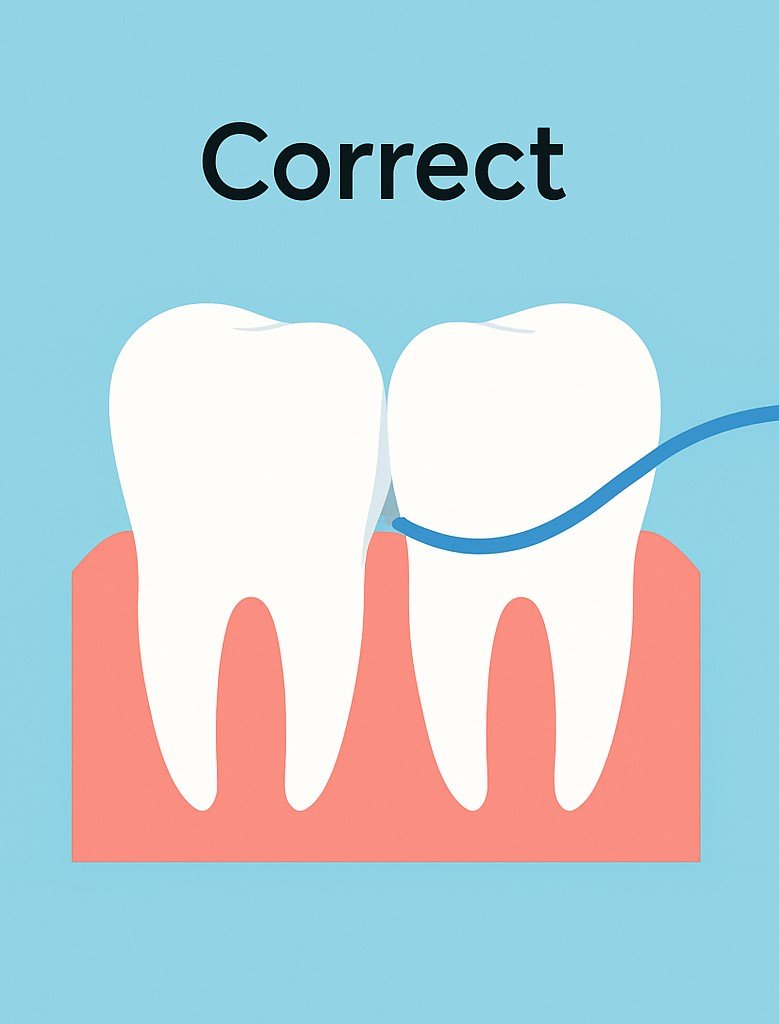This is How You Floss Like a Periodontist
We’ve all stood in front of the mirror, floss in hand, wondering am I actually doing this right?
You may even wonder if it matters that much to floss every day. Yes, it does. Daily flossing helps prevent or fight gingivitis.
And yet, most adults in the US don't floss daily (American Dental Association). More concerning, 20% don't floss at all!
Flossing is not only easy, it's super important to keeping your teeth and your gums healthy. At Kelner Periodontics, we see firsthand the difference proper flossing makes. Let’s see where most people go wrong and how you can floss like a periodontist.
Common Flossing Mistakes
1. Forgetting to Floss
Flossing isn't for only when you notice food is stuck in your teeth or right before your dental visits. Regular (daily) flossing significantly reduces gingivitis and plaque build-up compared to inconsistent flossing (Berchier et al., Journal of Clinical Periodontology, 2008).
2. Hastiness
Ideally, your teeth should contact their neighbors but have some space in between one another towards the gum line. Healthy gums tend to fill in this space. Snapping floss quickly through the contacts between your teeth can hurt your gums, leading to soreness and inflammation. Instead, slide the floss back and forth to gently pass throug the contact point along each side of the tooth to disrupt plaque biofilm without harming soft tissues (Lang et al., Clinical Oral Investigations, 2011).
3. Ignoring Tooth Contours
Effective flossing involves both curving floss around the side of each tooth to hug the surface and continuing down toward the base of the tooth just under the gum line. Flossing in a C-shape significantly reduces plaque and gingival bleeding compared to a simple up-down motion (Zimmer et al., Journal of Periodontology, 2006).
4. Neglecting the Back Teeth
Molars are more susceptible to plaque accumulation due to their location and shape. Not everyone realizes you need to floss behind your molars between the gum and the back of the tooth. However, this is an easy place for food to get caught without being as noticeable. Neglecting these teeth increases the risk of cavities and gum disease, as plaque left undisturbed can harden into tartar, promoting bacterial growth and inflammation (van der Weijden & Slot, International Journal of Dental Hygiene, 2011).
5. Using too Short a Strand
Reusing the same segment of floss transfers bacteria from tooth to tooth rather than removing it effectively. For most people, 18-24 inches of floss is enough to comfortably wind taround your fingers while having room to shift the floss as you move to each new tooth. Regularly moving to a clean floss segment helps reduce bacterial spread and maximizes plaque removal efficiency.
The Science Behind Effective Flossing
Flossing isn't just about dislodging food particles—it’s about disrupting the bacterial biofilm (plaque) that your toothbrush can't reach. Plaque houses pathogenic bacteria responsible for periodontal diseases. If not regularly disrupted, these bacteria trigger chronic gum inflammation (gingivitis), potentially progressing to periodontal disease, which means irreversible damage to the gums and bone supporting your teeth (Chapple et al., Journal of Clinical Periodontology, 2015).
Clinical studies have revealed significant reductions in dental plaque (up to 40%) and gingival inflammation (~50%) with regular, proper flossing (Graves et al., Journal of Dental Research, 2019). Additionally, research indicates flossing daily can help maintain periodontal attachment levels and reduce probing depths, critical markers of gum health (Goyal et al., Clinical Oral Investigations, 2021).
A randomized controlled trial demonstrated that participants who flossed daily experienced significantly less interproximal bleeding compared to non-flossers, underscoring the necessity of consistent flossing for periodontal health (Pizzo et al., European Journal of Oral Sciences, 2015). Flossing has also been shown to reduce levels of inflammatory markers such as C-reactive protein, indicating systemic health benefits linked to proper oral hygiene practices (Demmer et al., American Journal of Cardiology, 2012).
Ramifications of Poor or No Flossing
Ignoring flossing can have serious repercussions beyond just oral health:
- Gingivitis and Periodontitis: Persistent gum inflammation may escalate to periodontitis, leading to tooth mobility and eventual tooth loss.
- Systemic Health Risks: Poor gum health has been linked to diabetes complications, heart disease, stroke, and respiratory infections (Preshaw et al., Periodontology 2000, 2012).
- Increased Dental Costs: Advanced gum disease requires extensive treatments like scaling and root planing or even periodontal surgery, significantly increasing dental expenses.
Ideal Flossing Technique (Step-by-Step)
- Preparation: Cut 18–24 inches of floss and wind most of it around your middle fingers, leaving about two inches to floss with.
- Placement: Hold the floss firmly between your thumbs and forefingers (winding it around your forefingers can help your grip) and gently slide it between two teeth, being cautious not to snap it down into your gums.
- Flossing Motion: Curve the floss around one tooth, forming a C-shape, and gently glide it up and down the side of the tooth with a slight back-and-forth motion, reaching just beneath the gum line.
- Clean Sections: After cleaning one tooth surface, move to a clean section of floss before flossing the adjacent tooth surface.
- Repeat Thoroughly: Continue this methodical approach around every tooth, including behind your back molars.
FAQ: Common Flossing Concerns
Q: My gums bleed when I floss. Should I stop?
A: Occasional bleeding is common if you're new to flossing or haven't flossed regularly. Consistent flossing should reduce bleeding over a week or two. Persistent bleeding could indicate gum disease and warrants a dental visit.
Q: What if I find flossing painful or difficult due to arthritis?
A: Consider alternative tools like floss picks or water flossers, which are easier to manage and still effective. However, it is normal to find flossing painful if you have inflamed or bleeding gums. You may find that after a week or two, flossing becomes almost painless.
Q: Is flossing once per day sufficient?
A: Yes, flossing once daily is sufficient for most people to maintain good oral health. It is best to floss before bed every night, after you are done eating for the day.
Q: Should I floss before or after brushing my teeth?
A: Flossing before brushing allows fluoride from toothpaste to better reach between teeth and along the gum line, enhancing protection.
Q: Does it matter which type of floss I use?
A: Waxed floss is generally easier to use for tighter spaces, while unwaxed floss provides better grip on plaque. Choose according to your comfort and ease of use.
Water Flossers
Water flossers, like Waterpik®, use a pulsating stream of water to clean between the teeth and along the gumline. They’re especially popular with patients who find traditional floss awkward or uncomfortable.
Water flossers are easier to use for many people, particularly those with braces, dental implants, or limited dexterity. They’ve been shown to reduce gingival bleeding and inflammation, but they may not remove sticky plaque from tight tooth contacts as effectively as string floss.
Advantages
- User-friendly and gentle on gums
- Great for cleaning around orthodontic appliances, bridges, and implants
- Ideal for people with arthritis or coordination challenges
- Research shows improvement in gum health when used regularly
Limitations
- May not reach some tight spaces or below the gum line
- Can be messy for for novice users
Potential Risks
- Excessive pressure or improper angling can irritate gums or force bacteria into deeper pockets if used too aggressively
- The water pressure is not strong enought to damage enamel when used as directed
Best For
- Those with braces, palate expanders, bridges, etc.
- People with limited dexterity (e.g., arthritis)
Interdental Brush
Interdental brushes, like a Proxabrush®, are small, bristled tools that fit between your teeth to physically remove plaque. They’re most effective for patients with wider gaps between teeth or gum recession.
Unlike floss, which is thin and flexible, interdental brushes clean a broader surface area and require less fine motor skill. However, they can’t fit into very tight spaces and aren’t as universally applicable. For many patients they can be a good complement for floss, but are not a perfect substitute.
Advantages
- Easy to handle
- Works well with larger gaps and for periodontal maintenance
- Can be more efficient than floss at reducing plaque and inflammation in certain areas
- Quick to use once you know the right sizes
Limitations
- May not reach some tight spaces where floss is still required
- Brushes wear out and must be replaced often
- Often requires multiple sizes for different areas of the mouth
Potential Risks
- Risk of gum abrasion or enamel wear if the wrong size or improper technique is used
- Overly forceful insertion can damage gum tissue, especially if the brush is too large for the space
Best For
- Patients with periodontal disease, recession, or large interproximal gaps
- Those who struggle with floss but are consistent with routine cleaning
Make Flossing Part of Your Routine
At Kelner Periodontics, your oral health is our priority, and we understand flossing might seem basic. In fact, many patients feel embarrassed or hesitant to ask for help with something simple they assume they should already know how to do. Please don’t hesitate to ask about flossing. There's no shame in asking for clarification and we frequently give patients full tutorials on proper flossing. Improving your flossing technique is one of the easiest, cheapest, and most effective ways to improve your oral health.
We encourage you to bring up your flossing questions or concerns during your next visit to our office in Clark, New Jersey. Our professional team is eager to provide a comfortable demonstration to ensure you leave with renewed flossing confidence.
Remember, the best oral hygiene practices are ones you understand and implement well. Asking questions is an essential part of achieving optimal oral health.







